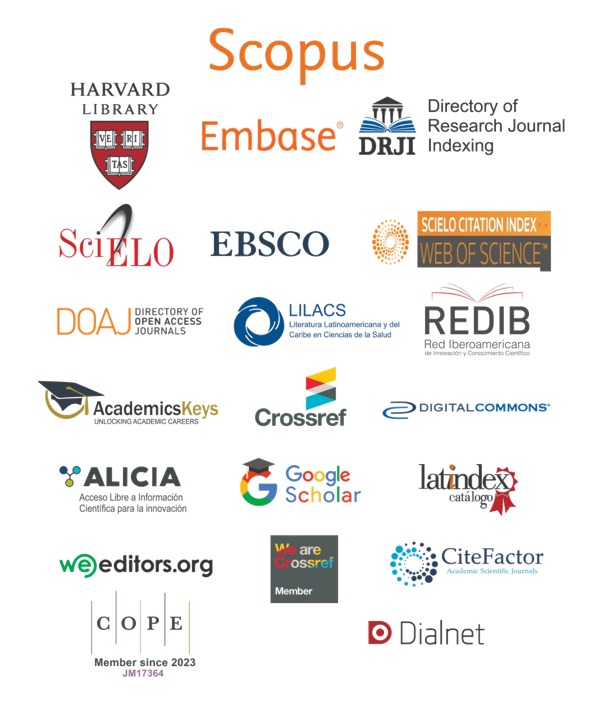Factors associated with poor adherence to haart in patients with HIV during the COVID-19 pandemic
Factores asociados a mala adherencia al targa en pacientes con VIH durante la pandemia por la COVID-19
DOI:
https://doi.org/10.25176/RFMH.v24i4.5785Keywords:
associated factor, poor adherence, HAART, HIVAbstract
Introduction: In the COVID-19 pandemic, the fear of contagion and the risk of poor evolution were conditions that circumscribed HIV-infected patients, potentially influencing adherence to HAART (A-HAART). Objective: To determine the factors associated with poor adherence to HAART (PA-TARGA) in patients with HIV during the COVID-19 pandemic in a hospital in northern Peru during April-October 2021. Material and Methods: A study was developed cross-sectional analytical study in 162 patients with a confirmed diagnosis of HIV infection on HAART. To establish A-HAART, the Morisky-Green-Levine Test was used. The association between sociodemographic, personal/family factors of COVID-19, health, and PA-HAART was evaluated using the Pearson Chi-square test, considering statistical significance for a p value < 0.05. The risk statistic was the Odds ratio (OR) > 1. Results: The prevalence of PA-HAART was 32%, the mean age 45.8±8.3 and 44.6±7.3 years (with poor and good adherence to HAART), predominantly male. Factors associated with PA-HAART were living alone (p=0,036, OR:3,1), personal history of COVID-19 (p=0,027, OR: 2,42), history of a close relative with COVID-19 (p =0,038, OR 3,42), depression (p=0,036, OR: 2,18) and comorbidity (p=0,027, OR: 2,21). Conclusion: In patients with HIV, living alone, a personal history of COVID-19, a history of a close relative with COVID-19, depression and presenting comorbidity are factors associated with PA-HAART.
Downloads
References
Algado-Sellés N, Gras-Valentí P, Chico-Sánchez P, Mora-Muriel JG, Soler-Molina VM, Hernández-Maldonado M, et al. Frecuency, asociated risk factors, and characteristics of COVID-19 among healthcare personnel in a Spanish health department. Am J Prev Med. 2020; 59(6): e22–e229. DOI: https://doi.org/10.1016/j.amepre.2020.07.014.
Palacios M, Santos E, Velásquez MA, León M. COVID-19, una emergencia de salud pública mundial. Rev Clin Esp. 2021; 221(1): 55-61. DOI: https://doi.org/10.1016/j.rce.2020.03.001.
Johns Hopkins University. COVID-19 Dashboard by the Center for Systems Science and Engineering (CSSE) at Johns Hopkins University (JHU), 2020 [Internet]. USA: JHU; 2020. [Accesado el 06 de Abril de 2023]. Disponible en: https://coronavirus.jhu.edu/map.html.
Instituto Nacional de Salud, Centro Nacional de Epidemiología, Prevención y Control de Enfermedades – MINSA. Sala Situacional COVID-19 Perú, 2020 [Internet]. Lima: INS, CDC Perú – MINSA; 2021. [Accesado el 06 de Abril de 2023]. Disponible en: https://www.dge.gob.pe/portalnuevo/covid-19/situacion-del-covid-19-en-el-peru/.
Cooper TJ, Woodward BL, Alom S, Harky A. Coronavirus disease 2019 (COVID-19) outcomes in HIV/AIDS patients: a systematic review. HIV Med. 2020; 21(9):567-577. DOI: https://doi.org/10.1111/hiv.12911.
Mirzaei H, McFarland W, Karamouzian M, Sharifi H. COVID-19 among people living with HIV: a systematic review. AIDS Behav. 2021; 25(1):85-92. DOI: https://doi.org/10.1007/s10461-020-02983-2.
Paredes JL, Navarro R, Cabrera DM, Diaz MM, Mejía F, Caceres CF. Los desafíos en la continuidad de atención de personas viviendo con VIH en el Perú durante la pandemia de la COVID-19. Rev Peru Med Exp Salud Publica. 2021; 38(1):166-70. DOI: https://doi.org/10.17843/rpmesp.2021.381.6471.
Posada-Vergara MP, Alzate-Ángel JC, Martínez-Buitrago E. COVID-19 and VIH. Colomb Med (Cali). 2020; 51(2): e4327. DOI: https://doi.org/10.25100/cm.v51i2.4327.
Marti M, Zürcher K, Enane LA, Diero L, Marcy O, Tiendrebeogo T, et al; IeDEA global consortium. Impact of the COVID-19 pandemic on TB services at ART programmes in low- and middle-income countries: a multi-cohort survey. J Int AIDS Soc. 2022; 25(10): e26018. DOI: https://doi.org/10.1002/jia2.26018.
Díez C, Del Romero-Raposo J, Mican R, López JC, Blanco JR, Calzado S, et al; for CoRIS. COVID-19 in hospitalized HIV-positive and HIV-negative patients: a matched study. HIV Med. 2021; 22(9): 867-76. DOI: https://doi.org/10.1111/hiv.13145.
Boyd MA, Boffito M, Castagna A, Estrada V. Rapid initiation of antiretroviral therapy at HIV diagnosis: definition, process, knowledge gaps. HIV Med. 2019; 20 Suppl 1:3-11. DOI: https://doi.org/10.1111/hiv.12708.
Abdulrahman SA, Ganasegeran K, Rampal L, Martins OF. HIV treatment adherence - a shared burden for patients, health-care providers, and other stakeholders. AIDS Rev. 2019;21(1):28-39. DOI: https://doi.org/10.24875/AIDSRev.19000037.
Rogers A, Brazier E, Dzudie A, Adedimeji A, Yotebieng M, Muhoza B, et al. COVID-19 associated changes in HIV service delivery over time in Central Africa: results from facility surveys during the first and second waves of the pandemic. PLoS One. 2022; 17(11): e0275429. DOI: https://doi.org/10.1371/journal.pone.0275429.
Del Amo J, Diaz A, Polo R. The impact of coronavirus disease 2019 on people with HIV. Curr Opin Infect Dis. 2022; 35(1): 9-14. DOI: https://doi.org/10.1097/QCO.0000000000000799.
SeyedAlinaghi S, Mirzapour P, Pashaei Z, Afzalian A, Tantuoyir MM, Salmani R, et al. The impacts of COVID-19 pandemic on service delivery and treatment outcomes in people living with HIV: a systematic review. AIDS Res Ther. 2023; 20(1): 4. DOI: https://doi.org/10.1186/s12981-022-00496-7.
Hudelson C, Cluver L. Factors associated with adherence to antiretroviral therapy among adolescents living with HIV/AIDS in low- and middle-income countries: a systematic review. AIDS Care. 2015; 27(7): 805-16. DOI: https://doi.org/10.1080/09540121.2015.1011073.
Chakraborty A, Hershow RC, Qato DM, Stayner L, Dworkin MS. Adherence to antiretroviral therapy among HIV patients in India: a systematic review and meta-analysis. AIDS Behav. 2020; 24(7): 2130-48. DOI: https://doi.org/10.1007/s10461-020-02779-4.
Ahmed A, Dujaili JA, Jabeen M, Umair MM, Chuah L-H, Hashmi FK, et al. Barriers and enablers for adherence to antiretroviral therapy among people living with HIV/AIDS in the era of COVID-19: a qualitative study from Pakistan. Front. Pharmacol. 2022; 12: 807446. DOI: https://doi.org/10.3389/fphar.2021.807446.
Zewude SB, Ajebe TM. Magnitude of optimal adherence and predictors for a low level of adherence among HIV/ AIDS-infected adults in South Gondar zone, Northwest Ethiopia: a multifacility cross-sectional study. BMJ Open 2022; 12: e056009. DOI: https://doi.org/10.1136/ bmjopen-2021-056009.
Cunha GH, Lima MAC, Siqueira LR, Fontenele MSM, Ramalho AKL, Almeida PC. Lifestyle and adherence to antiretrovirals in people with HIV in the COVID-19 pandemic. Rev Bras Enferm. 2022; 75(Suppl 2): e20210644. https://doi.org/10.1590/0034-7167-2021-0644.
Pérez-Bastán J, Viana-Castaño L. Factores asociados a la no adherencia terapéutica a los antirretrovirales en personas con VIH/SIDA. Revista Cubana de Medicina Tropical 2020; 72(2). [Accesado el 06 de Abril de 2023]. Disponible en: https://revmedtropical.sld.cu/index.php/medtropical/article/view/499
Barrera-Espinoza RW, Gómez-Gonzales WE, Girón-Vargas A, Arana-Escobar M, Nieva-Villegas LM, Gamarra-Bustillos C, et al. Factores asociados a la no adherencia al tratamiento antirretroviral en personas con VIH/SIDA. Horiz Med 2021; 21(4): e1498. DOI: https://doi.org/10.24265/horizmed.2021.v21n4.09.
Ley que establece los Derechos de las personas usuarias de los servicios de la salud. Ley N° 29414. Perú, 2009.
Asociación Médica Mundial. Declaración de Helsinki de la AMM – Principios éticos para las investigaciones médicas en seres humanos. Helsinsky: Asociación Médica Mundial; 2013.
Colegio Médico del Perú. Código de ética y deontología. Lima: Colegio Médico del Perú; 2007.
Quirós-Roldan E, Magro P, Carriero C, Chiesa A, El Hamad I, Tratta E, et al. Consequences of the COVID-19 pandemic on the continuum of care in a cohort of people living with HIV followed in a single center of Northern Italy. AIDS Res Ther. 2020; 17(1): 59. DOI: https://doi.org/10.1186/s12981-020-00314-y.
Varela M, Galdames S. Depresión y adhesión a terapia anti-retroviral en pacientes con infección por VIH atendidos en el Hospital San Pablo de Coquimbo, Chile. Rev. chil. infectol. 2014; 31(3): 323-8. DOI: http://dx.doi.org/10.4067/S0716-10182014000300011.
Jurado FD. Factores asociados a adherencia en pacientes con VIH/SIDA, de la unidad de atención integral de personas viviendo con VIH del Hospital General Enrique Garcés, Quito-Ecuador, julio a octubre 2014. [Tesis]. Pontificia Universidad Católica del Ecuador. Quito, Ecuador. 2015.
Linnemayr S, Jennings Mayo-Wilson L, Saya U, Wagner Z, MacCarthy S, Walukaga S, et al. HIV care experiences during the COVID-19 pandemic: mixed-methods telephone interviews with clinic-enrolled HIV-infected adults in Uganda. AIDS Behav. 2021; 25(1): 28–39. DOI: http://dx.doi.org/10.1007/s10461-020-03032-8.
Jewell BL, Mudimu E, Stover J, Ten Brink D, Phillips AN, Smith JA, et al. Potential effects of disruption to HIV programmes in sub-Saharan Africa caused by COVID-19: results from multiple mathematical models. Lancet HIV. 2020; 7(9): e629–40. DOI: https://doi.org/10.1016/S2352-3018(20)30211-3.
Urizar CA, Jarolin-Montiel M, Ayala-Servin N, Centurión-Wenninge C, Montiel-Garcete D. Factores asociados a la no adhrencia del tratamiento antirretroviral en pacientes con VIH en un hospital de Paraguay. Rev Cient Cienc Méd. 2020; 23(2): 166-74. DOI: https://doi.org/10.51581/rccm.v23i2.287.
Díaz-Agudelo TC. Comorbilidad de pacientes que viven con VIH y pertenecen al programa de atención integral de una IPS de Bucaramanga. [Tesis]. Universidad de Santander UDES. Bucaramanga, Colombia. 2019.
Jiménez-Pérez M, Caballero-Cruz G, Góngora-Valdés J, Iglesias-Sordo G, Galardy-Díaz J. Polifarmacia y adherencia farmacológica en adultos del Policlínico Docente “Louis Pasteur”. Univ Méd Pinareña. 2021; 17(2): e658. [Internet]. [Accesado el 06 de Abril de 2023]. Disponible en: https://revgaleno.sld.cu/index.php/ump/article/view/730.
Rivera YS. La polifarmacia y su relación con la adherencia al tratamiento en pacientes ambulatorios con diabetes tipo 2 en el Servicio de Endocrinología del Hospital Sergio Enrique Bernales. [Tesis]. Universidad Inca Garcilaso de la Vega. Lima, Perú. 2017.
Fernández CS and Ortega VL. Polypharmacy among HIV infected people aged 50 years or older. Colomb Med (Cali). 2019; 50(3): 142-52. DOI: http://dx.org/1025100/cm.v50i3.4128.
Gimeno-Gracia M, Sánchez-Rubio-Ferrández J, Robustillo-Cortés MA, Morillo-Verdugo R. Prevalencia de polifarmacia y complejidad farmacoterapéutica en personas mayores con VIH en España. Estudio POINT. Farm Hosp. 2020; 44(4): 127-34.

Downloads
Published
How to Cite
Issue
Section
License
Copyright (c) 2024 Revista de la Facultad de Medicina Humana

This work is licensed under a Creative Commons Attribution 4.0 International License.



































